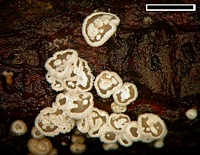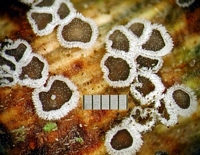|
 Lachnella alboviolascens Lachnella alboviolascens
SynonymsCyphella alboviolascens
Lachnella alboviolascens
Peziza alboviolascens
BiostatusPresent in region - Indigenous
Images (click to enlarge)
Caption: scale=2mm
Owner: J.A. Cooper | 
Caption: scale=5mm.
Owner: J.A. Cooper |
Article: Cunningham, G.H. (1963). The Thelephoraceae of Australia and New Zealand. New Zealand Department of Scientific and Industrial Research, Bulletin 145: 359 p. Wellington:.
Description: Pilei annual, scattered or gregarious, membranous, at first subglobose, becoming disciform or
pezizaeform, 0.25-1.25 mm diameter, attached by brief bases; exterior white, covered with a
dense tomentum of abhymenial hairs which curve over the hymenium and fringe the
substratum,, hairs filiform, 4-6 µm diameter, finely crystal encrusted; margin fimbriate,
inturned; hymenial layer even, cream or pallid buff, concave. Context white, to 80 µm thick,
of radiately arranged compact hyphae; generative hyphae 3-4 µm diameter, walls 0.25 µm
thick, hyaline, tinted in a few outer hyphae. Hymenial layer to 80 µm deep, a dense palisade
of basidia and paraphyses. Basidia subclavate, 50-80 x 11-14 µm, bearing 2-4 spores;
sterigmata arcuate, slender, to 7 µm long. Paraphyses subclavate, 45-65 x 9-11 µm. Spores
irregular, obovate, pyriform, limoniform, or triangular with rounded angles, often biapiculate,
12-17 x 9-11 µm, walls smooth, hyaline, 0.25 µm thick.
Habitat: HABITAT: Scattered or crowded on bark of dead twigs.
Distribution: DISTRIBUTION: Europe, North America, New Zealand.
Notes: Although close to L. villosa in macrofeatures, the species may be separated by the larger
basidia and almost triangular spores with rounded angles and oblique apiculi. Only a few
spores exhibit this feature, others being obovate, pyriform, or limoniform, often with two
apiculi. In the original description the hymenial surface was said to be violaceous, but in
collections examined in Kew herbarium, and those present in this region, it is cream or buff.
|